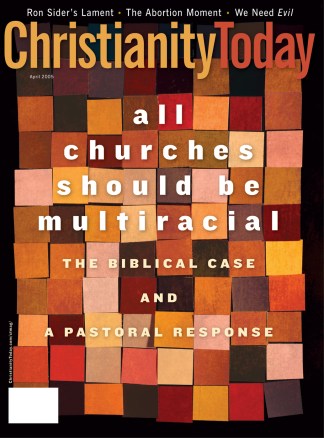Scot McKnight’s The Jesus Creed: Loving God, Loving Others (Paraclete, 2004) shows how an ancient Jewish prayer, the Shema, encouraged early Christians to emphasize love—and how it can form us spiritually today. A professor of religious studies at North Park University, McKnight complements his study of first-century Christian/Jewish practices with stories from history and his life. Joseph B. Modica, chaplain at Eastern University, interviewed McKnight at a recent talk at the school.
The Jesus Creed: Loving God, Loving Others – 15th Anniversary Edition
Paraclete Press
335 pages
$11.57
How is your book different from other books on spiritual formation?
Most books emphasize the things we have to do to be better Christians, and I focus on the end of spiritual formation—namely, loving God and loving others.
This book also is more historically concerned with what formation was like in the first century for a follower of Jesus. And it is more of an organic, historical presentation of the life and teachings of Jesus to help us understand spiritual formation, rather than a theory of spiritual formation that finds proof texts.
What was Jesus’ process of spiritual formation?
Because Christians believe Jesus is the Second Person of the Trinity, there’s a sense for some that Jesus just automatically was a spiritually mature person from the beginning. This, if you read between the lines, is Docetism [the heresy that Jesus only seemed to appear in the flesh].
The Gospels teach us in Luke 2 that Jesus grew in stature and wisdom. So we can assume that Jesus as a human being grew spiritually. The first formative factor was his parents.
Joseph was a righteous man, totally committed to the Torah. Suddenly, God reveals to him that he’s going to marry a woman who’s pregnant by means of the Holy Spirit, and that he will have to learn to live in his identity before God rather than in light of the reputation he had in Jewish society.
Jesus’ mother, Mary, was also a powerful spiritual influence. We learn from the Magnificat that Mary was a profoundly spiritual person. She knew the Scriptures, she knew the hopes of Israel, and she longed for that day. So we find Jesus, who’s willing to do what God calls him to do in spite of reputation, like Joseph. We find that he lives out those values that his mother expressed in the Magnificat.
The second formative factor was the sacred rhythms of Israel. Jesus was influenced by the repetition of the Shema [Deut. 6:4-9, “Hear O Israel: The Lord our God, the Lord is one. …”], which was a common Jewish custom at that time. And he would have been influenced by the synagogue Shabbat service, the calendar of Israel, and the great acts of God in history displayed in the feasts of Israel.
What then is the Jesus Creed?
“Hear O Israel: The Lord our God, the Lord is one. Love the Lord your God … and [Lev. 19:18] love your neighbor as yourself.” Jesus likely recited this two times a day, as good Jews did. I’m asking readers to do the same—to experiment for a month or so with reciting this creed to see the subtle impact it makes on day-to-day living.
Do you have evidence that early Christians used this modified Shema in their worship or prayers?
It’s a great question, and I’m tempted to answer each time: “Much in every way.”
Whether he or his followers recited it with this addition of Leviticus 19:18, we don’t know. But the Jesus Creed is so prominent in their teachings that its substance is clearly the most important thing for Christian living. It’s unlikely that as a creedal confessing community, believing Jews would not have been repeating the Shema.
What Jesus taught in this creed shows up in three major Christian leaders. Paul says in Romans 13:8-10 that our whole obligation before God can be summarized in “Love your neighbor as yourself.” This clearly comes from Jesus; it’s just like what Jesus told the rich young ruler.
A second leader is the brother of Jesus, James, who summarizes the law as the perfect law of liberty, which is to love your neighbor as yourself. And then in John 13, the apostle John throws love right into the center of everything. In 1 John, John talks about loving one another as the great new commandment that Jesus has taught his disciples. So while none of these apostles clearly says, “This is what we recite daily,” these elements indicate that the theme of the Shema was very much at the center of their thinking.
By the time we get to the early Christian handbook on the Christian life, the Didache, and look at the first few lines, it tells us there are two ways of life: one that leads to life and one that leads to death. The one that leads to life is to love God and to love others, and this in a text emphasizing praying three times a day. We see this in the early fathers as well.
So it’s very unlikely that the followers of Jesus would not also have practiced the Jesus Creed as a form of spiritual formation because it shows up in these early Christian writings.
If Jesus intended to teach this modified Shema, why does it only appear in polemical passages [answering scribes and Pharisees], rather than in instructional settings like the Sermon on the Mount?
First, just because something is said in a “polemical” context does not mean the saying is somehow weakened. It is often in polemical settings that one’s central creedal affirmations are expressed. Thus, the Nicene Creed only came to fruition because of the Arian controversy, and the emphasis on justification by faith [alone] came to fruition because of bitter polemics with Roman Catholic theologians. Pressure frequently leads one to ground-level beliefs.
Second, there is clearly a positive dimension in Jesus’ words to the rich young ruler when he caps off the second half of the Ten Commandments by appealing to Leviticus 19:18—thus giving his positive understanding of what the commandments were really all about.
Third, the love commandment does show up in the Sermon on the Mount, namely in the Golden Rule. “Do to others what you want them to do to you” is precisely what the second half of the Jesus Creed is all about, namely, “Love others as yourself.”
Love has come to have sentimental overtones. Does using that word blunt the radical demands of Jesus’ teaching?
Love has been weakened in our culture. And U.S. culture has made tolerance the paramount form of love. It is supposedly the foundational ethic of all cultures in Western civilized pluralistic society. But tolerance is an insipid and limp form of what Jesus calls his followers to do.
So I’m asking Christians to reconsider making love the centerpiece of Christian ethics and lifestyle. I define love of God as yearning for, praying for, and working for what glorifies God, and love of others as yearning for, praying for, and working for what God wants for another person.
It is easy to practice tolerance, and very difficult to practice love.
Joseph B. Modica is chaplain at Eastern University.
Copyright © 2005 Christianity Today. Click for reprint information.
Related Elsewhere:
The Jesus Creed is available from Christianbook.com and other book retailers.
An excerpt and author information are available from the publisher.
Our Books & Culture Corner weekly reviews books. More reviews and interviews are available from our Book page, as well as our 2004 Book Awards page.











